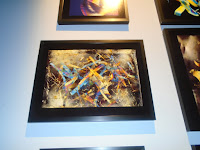1. For each video and article list/discuss the key concepts you learned.
In the first video, Aesthetics:Philosophy of Arts, I learned the actual definition for aesthetics, which is, the philosophical study of beauty and art. I thought it was very interesting to think about the idea that beauty and art are different from eachother. I think many people think that they are the same thing and that art must be beautiful to be good. The example of Picasso was given as art that may not be considered "pretty" or beautiful. This video moved in order from ancient Athens to modern day philosophy. I found it interesting that Plato actually thought of art as treasonous because it "copied" reality and emotion, while Aristotle said arousing emotion from art was good. I also enjoyed Hutchenson's explanation of art. He said that people need to disengage from reality to enjoy art. He also put a limit on all art being beautiful by saying that disgusting images can never be beautiful. I agreed most with Kant's opinion that there is no exact science of beautiful. Art is a lot like literature according to Schiller who said that art makes us more human and moral.I really enjoyed thinking about the ideas of art and beauty that were presented in this video. I learned that by the 20th century this whole idea of beauty was challenged and forgotten and by the1960s most of this philosophy had no place in art. This was a very good educational video focused on the history of art.
The CARTA video on Neurobiology and Neurology of Aesthetics was also intersting. It definitely made me think that maybe I was wrong and that there are some facts about what is actually beautiful. I enjoyed the statement that art is the artists attempt to share his conception of the world and that it makes us more aware.
The CNN video discussed the idea of symmetry and that the reason we like symmetrical appearing things is that most LIVING things have symmetry. I learned that we readily recognize faces for biological reasons and can see faces in many images:) Exaggerated features may still please the emotional part of the brain according to this video.
2. Which philosopher's theroy on aesthetics do you feel is most important? Be sure to mention the philosphers name, era (time in history), and contribution to the aesthetic theory in your response.
I felt that Aristotle, an ancient Greek philosopher, may have had the most valuable theory on art and aesthetics because his was a shift from Plato, who did not like or trust art. Aristotle understood art more as we do today. He came up with modern ideas such as order and symmetry in art and he gave order and logic to tragedies. I like that he called for a logical plot set in one location with the event happening over the period of a day. This prevails as the recipe for many good dramas today.
3. What do you think about Changeux and Ramachandran scientific view of aesthetics and art? What was the most interesting fact you discovered from each speakers lecture?
These two speaker were very interesting to listen to and also quite different. I did find the most parts of both speeches to be the actual brain images they displayed. The images did prove that there is more science to art than I thought. Changeux said that empathy for suffering seen in art actually showed in the brain images. This supports his statement that art makes us more aware. Ramachandran stated that the goal of art was to distort such as Picasso. He also insisted that there is a science to art and that there are universal principles of art that cut across all cultures. I found the most interesting part of his lecture to be the part comparing the placement of beauty marks and the effect of placement whether it was beautiful or not. This got me thinking about the meaning of aesthetics and whether or not I truly understood it.
4. How do the videos and article relate to the readings in the text?
The videos, articles, and textbook all allow students to not only learn some art history, but to look at the specific artists of different eras. I liked how the book did a close up study of specific artists. All three resources addressed the challenge of defining art and all agreed that it is valuable to society. The book has a lot more detail about techniques and specific types of art than the other online sources.
5. What is your opinion of the films and article? How do they add depth to understanding of the topics in your reading in the text?
I enjoyed both films and the article. I thought I needed the first film most in order to learn a bit of history and evolution of art .It made me appreciate how different some modern art is from the past. I think that all of this art somehow has a place today and that new art forms are likely being created as we speak. The speakers made me think of art in a more scientific way. I enjoyed Changeaux a bit more because I loved that he brought forth the idea that art can bring emotion and awareness. I agree that a powerful image can create empathy for a person or situation and I like this function of art. I didn't enjoy Ramachandran's list of principles as much and simply dont agree that we should have that kind of list related to art. The CNN article was a nice, short way to explain why symmetry in art is important. I enjoyed that because I have always known that symmetry is considered a good thing and now I know why!




























